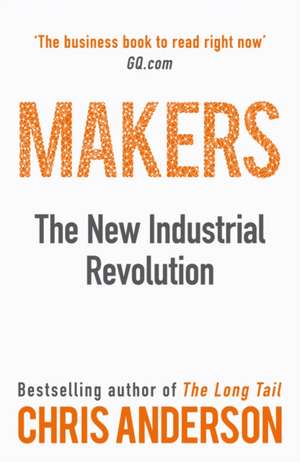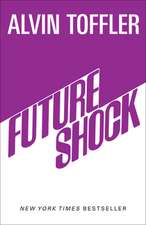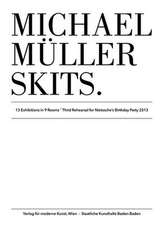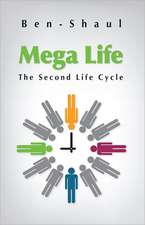Makers
Autor Chris Andersonen Limba Engleză Paperback – 3 apr 2013
| Toate formatele și edițiile | Preț | Express |
|---|---|---|
| Paperback (2) | 99.95 lei 3-5 săpt. | +8.41 lei 4-10 zile |
| CORNERSTONE – 3 apr 2013 | 99.95 lei 3-5 săpt. | +8.41 lei 4-10 zile |
| Crown Business – 7 apr 2014 | 108.50 lei 3-5 săpt. | |
| Hardback (1) | 137.06 lei 18-29 zile | +13.39 lei 999-0 zile |
| Cornerstone – 12 sep 2012 | 137.06 lei 18-29 zile | +13.39 lei 999-0 zile |
Preț: 99.95 lei
Nou
Puncte Express: 150
Preț estimativ în valută:
19.13€ • 19.90$ • 15.79£
19.13€ • 19.90$ • 15.79£
Carte disponibilă
Livrare economică 24 martie-07 aprilie
Livrare express 07-13 martie pentru 18.40 lei
Preluare comenzi: 021 569.72.76
Specificații
ISBN-13: 9781847940674
ISBN-10: 1847940676
Pagini: 272
Ilustrații: Illustrations, ports.
Dimensiuni: 130 x 198 x 30 mm
Greutate: 0.2 kg
Editura: CORNERSTONE
ISBN-10: 1847940676
Pagini: 272
Ilustrații: Illustrations, ports.
Dimensiuni: 130 x 198 x 30 mm
Greutate: 0.2 kg
Editura: CORNERSTONE
Recenzii
"A thrilling manifesto, a call to arms to quit your day job, pick up your tools, and change the future of manufacturing and business forever.” ߝBoingBoing
"Chris Anderson has been called many things: a visionary, a pioneer of the Internet economy, a proselytizer of DIY 2.0. But it's probably more apt to think of him as a weather vane: He might not control the winds of change, but he's often the first to see which way they're blowing." -Foreign Policy
"Chris understands that the owners of the means of production get to decide what is produced. And now you're the owner. This book will change your life, whether you read it or not, so I suggest you get in early." ߝSeth Godin, bestselling author of Tribes and Purple Cow
“A visionary preview of the next technological revolution. If you want to know where the future is headed, start here.” ߝTom Rath, author of StrengthsFinder 2.0
“Makers is must read for understanding the transformative changes that are shaping, and will shape, the future of inventing.” ߝDan Ariely, author of Predictably Irrational and The Upside of Irrationality
"Inspiring and engaging. Anderson delivers a compelling blueprint of a future where America can lead in making things again." ߝElon Musk, co-fouder of Tesla Motors and CEO of SpaceX
“In Makers, Chris Anderson gives us a fascinating glimpse of a hands-on future, a future where ‘if you can imagine it, you can build it.’” ߝDan Heath, co-author of Switch and Made to Stick
“For those who have marveled at the way software has helped disrupt industry after industry - buckle up, that wave is coming soon to an industry near you. Chris Anderson has written a compelling and important book about how technology is about to completely shake up how America makes things. Required reading for entrepreneurs, policy makers, and leaders who want to survive and thrive in this brave new world.” ߝEric Ries, author of The Lean Startup
"The Maker movement powered by desktop manufacturing will revolutionize the global economy. Chris Anderson once again reinvents the future in "Makers": a big vision driven by down-to-earth and practical ideas. A must read for anyone who wants to see the leading edge of change." ߝPeter Schwartz, Co-founder of Global Business Network and author of The Art of the Long View
From the Hardcover edition.
"Chris Anderson has been called many things: a visionary, a pioneer of the Internet economy, a proselytizer of DIY 2.0. But it's probably more apt to think of him as a weather vane: He might not control the winds of change, but he's often the first to see which way they're blowing." -Foreign Policy
"Chris understands that the owners of the means of production get to decide what is produced. And now you're the owner. This book will change your life, whether you read it or not, so I suggest you get in early." ߝSeth Godin, bestselling author of Tribes and Purple Cow
“A visionary preview of the next technological revolution. If you want to know where the future is headed, start here.” ߝTom Rath, author of StrengthsFinder 2.0
“Makers is must read for understanding the transformative changes that are shaping, and will shape, the future of inventing.” ߝDan Ariely, author of Predictably Irrational and The Upside of Irrationality
"Inspiring and engaging. Anderson delivers a compelling blueprint of a future where America can lead in making things again." ߝElon Musk, co-fouder of Tesla Motors and CEO of SpaceX
“In Makers, Chris Anderson gives us a fascinating glimpse of a hands-on future, a future where ‘if you can imagine it, you can build it.’” ߝDan Heath, co-author of Switch and Made to Stick
“For those who have marveled at the way software has helped disrupt industry after industry - buckle up, that wave is coming soon to an industry near you. Chris Anderson has written a compelling and important book about how technology is about to completely shake up how America makes things. Required reading for entrepreneurs, policy makers, and leaders who want to survive and thrive in this brave new world.” ߝEric Ries, author of The Lean Startup
"The Maker movement powered by desktop manufacturing will revolutionize the global economy. Chris Anderson once again reinvents the future in "Makers": a big vision driven by down-to-earth and practical ideas. A must read for anyone who wants to see the leading edge of change." ߝPeter Schwartz, Co-founder of Global Business Network and author of The Art of the Long View
From the Hardcover edition.
Notă biografică
CHRIS ANDERSON is the editor in chief of Wired, which he has led to multiple National Magazine Award nominations, as well as winning the prestigious top prize for General Excellence in 2005, 2007, and 2009. In 2009, the magazine was named Magazine of the Decade by the editors of AdWeek. He is the co-founder of 3D Robotics, a fast-growing manufacturer of aerial robots, and DIY Drones. Anderson is the author of the New York Times bestseller The Long Tail and Free: The Future of a Radical Price. He lives in the San Francisco Bay Area.
From the Hardcover edition.
From the Hardcover edition.
Extras
Chapter 1
The Invention Revolution
Fred Hauser, my maternal grandfather, emigrated to Los Angeles from Bern, Switzerland, in 1926. He was trained as a machinist, and perhaps inevitably for Swiss mechanical types, there was a bit of the watchmaker in him, too. Fortunately, at that time the young Hollywood was something of a clockwork industry, too, with its mechanical cameras, projection systems, and the new technology of magnetic audio strips. Hauser got a job at MGM Studios working on recording technology, got married, had a daughter (my mom), and settled in a Mediterranean bungalow on a side street in Westwood where every house had a lush front lawn and a garage in the back.
But Hauser was more than a company engineer. By night, he was also an inventor. He dreamed of machines, drew sketches and then mechanical drawings of them, and built prototypes. He converted his garage to a workshop, and gradually equipped it with the tools of creation: a drill press, a band saw, a jig saw, grinders, and, most important, a full-size metal lathe, which is a miraculous device that can, in the hands of an expert operator, turn blocks of steel or aluminum into precision-machined mechanical sculpture ranging from camshafts to valves.
Initially his inventions were inspired by his day job, and involved various kinds of tape-transport mechanisms. But over time his attention shifted to the front lawn. The hot California sun and the local mania for perfect green-grass plots had led to a booming industry in sprinkler systems, and as the region grew prosperous, gardens were torn up to lay irrigation systems. Proud homeowners came home from work, turned on the valves, and admired the water-powered wizardry of pop‑up rotors, variable-stream nozzles, and impact sprinkler heads spreading water beautifully around their plots. Impressive, aside from the fact that they all required manual intervention, if nothing more than just to turn on the valves in the first place. What if they could be driven by some kind of clockwork, too?
Patent number 2311108 for “Sequential Operation of Service Valves,” filed in 1943, was Hauser’s answer. The patent was for an automatic sprinkler system, which was basically an electric clock that turned water valves on and off. The clever part, which you can still find echoes of today in lamp timers and thermostats, is the method of programming: the “clock” face is perforated with rings of holes along the rim at each five-minute mark. A pin placed in any hole triggers an electrical actuator called a solenoid, which toggles a water valve on or off to control that part of the sprinkler system. Each ring represented a different branch of the irrigation network. Together they could manage an entire yard—front, back, patio, and driveway areas.
Once he had constructed the prototype and tested it in his own garden, Hauser filed his patent. With the patent application pending, he sought to bring it to market. And there was where the limits of the twentieth-century industrial model were revealed.
It used to be hard to change the world with an idea alone. You can invent a better mousetrap, but if you can’t make it in the millions, the world won’t beat a path to your door. As Marx observed, power belongs to those who control the means of production. My grandfather could invent the automatic sprinkler system in his workshop, but he couldn’t build a factory there. To get to market, he had to interest a manufacturer in licensing his invention. And that is not only hard, but requires the inventor to lose control of his or her invention. The owners of the means of production get to decide what is produced.
In the end, my grandfather got lucky—to a point. Southern California was the center of the new home irrigation industry, and after much pitching, a company called Moody agreed to license his automatic sprinkler system. In 1950 it reached the market as the Moody Rainmaster, with a promise to liberate homeowners so they could go to the beach for the weekend while their gardens watered themselves. It sold well, and was followed by increasingly sophisticated designs, for which my grandfather was paid royalties until the last of his automatic sprinkler patents expired in the 1970s.
This was a one-in-a-thousand success story; most inventors toil in their workshops and never get to market. But despite at least twenty-six other patents on other devices, he never had another commercial hit. By the time he died in 1988, I estimate he had earned only a few hundred thousand dollars in total royalties. I remember visiting the company that later bought Moody, Hydro-Rain, with him as a child in the 1970s to see his final sprinkler system model being made. They called him “Mr. Hauser” and were respectful, but it was apparent they didn’t know why he was there. Once they had licensed the patents, they then engineered their own sprinkler systems, designed to be manufacturable, economical, and attractive to the buyer’s eye. They bore no more resemblance to his prototypes than his prototypes did to his earliest tabletop sketches.
This was as it must be; Hydro-Rain was a company making many tens of thousands of units of a product in a competitive market driven by price and marketing. Hauser, on the other hand, was a little old Swiss immigrant with an expiring invention claim who worked out of a converted garage. He didn’t belong at the factory, and they didn’t need him. I remember that some hippies in a Volkswagen yelled at him for driving too slowly on the highway back from the factory. I was twelve and mortified. If my grandfather was a hero of twentieth-century capitalism, it certainly didn’t look that way. He just seemed like a tinkerer, lost in the real world.
Yet Hauser’s story is no tragedy; indeed, it was a rare success story from that era. My grandfather was, as best I can remember (or was able to detect; he fit the caricature of a Swiss engineer, more comfortable with a drafting pencil than with conversation), happy, and he lived luxuriously by his standards. I suspect he was compensated relatively fairly for his patent, even if my stepgrandmother (my grandmother died early) complained about the royalty rates and his lack of aggression in negotiating them. He was by any measure an accomplished inventor. But after his death, as I went through his scores of patent filings, including a clock timer for a stove and a Dictaphone-like recording machine, I couldn’t help but observe that of his many ideas, only the sprinklers actually made it to market at all.
Why? Because he was an inventor, not an entrepreneur. And in that distinction lies the core of this book.
It used to be hard to be an entrepreneur. The great inventor/businessmen of the First Industrial Revolution, such as James Watt and Matthew Boulton of steam-engine fame, were not just smart but privileged. Most were either born into the ruling class or lucky enough to be apprenticed to one of the elite. For most of history since then, entrepreneurship has meant either setting up a corner grocery shop or some other sort of modest local business or, more rarely, a total pie-in-the-sky crapshoot around an idea that is more likely to bring ruination than riches.
Today we are spoiled by the easy pickings of the Web. Any kid with an idea and a laptop can create the seeds of a world-changing company—just look at Mark Zuckerberg and Facebook or any one of thousands of other Web startups hoping to follow his path. Sure, they may fail, but the cost is measured in overdue credit-card payments, not lifelong disgrace and a pauper’s prison.
The beauty of the Web is that it democratized the tools both of invention and of production. Anyone with an idea for a service can turn it into a product with some software code (these days it hardly even requires much programming skill, and what you need you can learn online)—no patent required. Then, with a keystroke, you can “ship it” to a global market of billions of people.
Maybe lots of people will notice and like it, or maybe they won’t. Maybe there will be a business model attached, or maybe there won’t. Maybe riches lie at the end of this rainbow, or maybe they don’t. But the point is that the path from “inventor” to “entrepreneur” is so foreshortened it hardly exists at all anymore.
Indeed, startup factories such as Y Combinator now coin entrepreneurs first and ideas later. Their “startup schools” admit smart young people on the basis of little more than a PowerPoint presentation. Once admitted, the would-be entrepreneurs are given spending money, whiteboards, and desk space and told to dream up something worth funding in three weeks.
Most do, which says as much about the Web’s ankle-high barriers to entry as it does about the genius of the participants. Over the past six years, Y Combinator has funded three hundred such companies, with such names as Loopt, Wufoo, Xobni, Heroku, Heyzap, and Bump. Incredibly, some of them (such as DropBox and Airbnb) are now worth billions of dollars. Indeed, the company I work for, Condé Nast, even bought one of them, Reddit, which now gets more than 2 billion page views a month. It’s on its third team of twentysomething genius managers; for some of them, this is their first job and they’ve never known anything but stratospheric professional success.
But that is the world of bits, those elemental units of the digital world. The Web Age has liberated bits; they are cheaply created and travel cheaply, too. This is fantastic; the weightless economics of bits has reshaped everything from culture to economics. It is perhaps the defining characteristic of the twenty-first century (I’ve written a couple of books on that, too). Bits have changed the world.
We, however, live mostly in the world of atoms, also known as the Real World of Places and Stuff. Huge as information industries have become, they’re still a sideshow in the world economy. To put a ballpark figure on it, the digital economy, broadly defined, represents $20 trillion of revenues, according to Citibank and Oxford Economics. The economy beyond the Web, by the same estimate, is about $130 trillion. In short, the world of atoms is at least five times larger than the world of bits.
We’ve seen what the Web’s model of democratized innovation has done to spur entrepreneurship and economic growth. Just imagine what a similar model could do in the larger economy of Real Stuff. More to the point, there’s no need to imagine—it’s already starting to happen. That’s what this book is about. There are thousands of entrepreneurs emerging today from the Maker Movement who are industrializing the do-it-yourself (DIY) spirit. I think my grandfather, as bemused as he might be by today’s open-source and online “co-creation,” would resonate with the Maker Movement. Indeed, I think he might be proud.
The making of a Maker
In the 1970s, I spent some of my happiest childhood summers with my grandfather in Los Angeles, visiting from my home on the East Coast and learning to work with my hands in his workshop. One spring, he announced that we would be making a four-stroke gasoline engine and that he had ordered a kit we could build together. When I arrived in Los Angeles that summer, the box was waiting. I had built my share of models, and opened the box expecting the usual numbered parts and assembly instructions. Instead, there were three big blocks of metal and a crudely cast engine casing. And a large blueprint, a single sheet folded many times.
“Where are the parts?” I asked. “They’re in there,” my grandfather replied, pointing to the metal blocks. “It’s our job to get them out.” And that’s exactly what we did that summer. Using the blueprint as a guide, we cut, drilled, ground, and turned those blocks of metal, extracting a crankshaft, piston and rod, bearings, and valves out of solid brass and steel, much as an artist extracts a sculpture from a block of marble. As the pile of metal curlicues from the steel turning on the lathe grew around my feet, I marveled at the power of tools and skilled hands (my grandfather’s, not mine). We had conjured a precision machine from a lump of metal. We were a mini-factory, and we could make anything.
But as I got older, I stopped returning to my grandfather’s workshop and forgot about my fascination with making things. Blame screens. My generation was the first to get personal computers, and I was more enthralled with them than with anything my grandfather could make. I learned to program, and my creations were in code, not steel. Tinkering in a workshop seemed trivial compared to unlocking the power of a microprocessor.
Zines, Sex Pistols, and the birth of Indie
When I reached my twenties, I had my second DIY moment. I was living in Washington, D.C., in the early 1980s, when it was one of the hotspots of the American punk rock movement. Bands such as Minor Threat and the Teen Idles were being formed by white suburban teenagers and playing in church basements. Despite not knowing how to play an instrument and having limited talent, I got caught up in the excitement of the moment and played in some of the lesser bands in the scene. It was eye-opening.
Like all garage rock and roll, all you needed to be in a band was an electric guitar and an amp. But what was new about the 1980s punk phenomenon was that the bands did more than just play; they also started to publish. Photocopiers were becoming common, and from them arose a “zine” culture of DIY magazines that were distributed at stores and shows and by mail. Cheap four-track tape recorders allowed bands to record and mix their own music, without a professional studio. And a growing industry of small vinyl-pressing plants let them make small-batch singles and EPs, which they sold via mail order and local shops.
This was the start of the DIY music industry. The tools of the major labels—recording, manufacturing, and marketing music—were now in the hands of individuals. Eventually some of these bands, led by Minor Threat and then Fugazi, started their own indie label, Dischord, which eventually produced hundred of records and is still running today. They didn’t need to compromise their music to get published, and they didn’t need to sell in big numbers or get radio play. They could find their own fans; indeed, the fans found them via word of mouth, and postcards poured into such micro-labels to order music that couldn’t be found in most stores. The relative obscurity conferred authenticity and contributed to the rise of the global underground that defines Web culture today.
The Invention Revolution
Fred Hauser, my maternal grandfather, emigrated to Los Angeles from Bern, Switzerland, in 1926. He was trained as a machinist, and perhaps inevitably for Swiss mechanical types, there was a bit of the watchmaker in him, too. Fortunately, at that time the young Hollywood was something of a clockwork industry, too, with its mechanical cameras, projection systems, and the new technology of magnetic audio strips. Hauser got a job at MGM Studios working on recording technology, got married, had a daughter (my mom), and settled in a Mediterranean bungalow on a side street in Westwood where every house had a lush front lawn and a garage in the back.
But Hauser was more than a company engineer. By night, he was also an inventor. He dreamed of machines, drew sketches and then mechanical drawings of them, and built prototypes. He converted his garage to a workshop, and gradually equipped it with the tools of creation: a drill press, a band saw, a jig saw, grinders, and, most important, a full-size metal lathe, which is a miraculous device that can, in the hands of an expert operator, turn blocks of steel or aluminum into precision-machined mechanical sculpture ranging from camshafts to valves.
Initially his inventions were inspired by his day job, and involved various kinds of tape-transport mechanisms. But over time his attention shifted to the front lawn. The hot California sun and the local mania for perfect green-grass plots had led to a booming industry in sprinkler systems, and as the region grew prosperous, gardens were torn up to lay irrigation systems. Proud homeowners came home from work, turned on the valves, and admired the water-powered wizardry of pop‑up rotors, variable-stream nozzles, and impact sprinkler heads spreading water beautifully around their plots. Impressive, aside from the fact that they all required manual intervention, if nothing more than just to turn on the valves in the first place. What if they could be driven by some kind of clockwork, too?
Patent number 2311108 for “Sequential Operation of Service Valves,” filed in 1943, was Hauser’s answer. The patent was for an automatic sprinkler system, which was basically an electric clock that turned water valves on and off. The clever part, which you can still find echoes of today in lamp timers and thermostats, is the method of programming: the “clock” face is perforated with rings of holes along the rim at each five-minute mark. A pin placed in any hole triggers an electrical actuator called a solenoid, which toggles a water valve on or off to control that part of the sprinkler system. Each ring represented a different branch of the irrigation network. Together they could manage an entire yard—front, back, patio, and driveway areas.
Once he had constructed the prototype and tested it in his own garden, Hauser filed his patent. With the patent application pending, he sought to bring it to market. And there was where the limits of the twentieth-century industrial model were revealed.
It used to be hard to change the world with an idea alone. You can invent a better mousetrap, but if you can’t make it in the millions, the world won’t beat a path to your door. As Marx observed, power belongs to those who control the means of production. My grandfather could invent the automatic sprinkler system in his workshop, but he couldn’t build a factory there. To get to market, he had to interest a manufacturer in licensing his invention. And that is not only hard, but requires the inventor to lose control of his or her invention. The owners of the means of production get to decide what is produced.
In the end, my grandfather got lucky—to a point. Southern California was the center of the new home irrigation industry, and after much pitching, a company called Moody agreed to license his automatic sprinkler system. In 1950 it reached the market as the Moody Rainmaster, with a promise to liberate homeowners so they could go to the beach for the weekend while their gardens watered themselves. It sold well, and was followed by increasingly sophisticated designs, for which my grandfather was paid royalties until the last of his automatic sprinkler patents expired in the 1970s.
This was a one-in-a-thousand success story; most inventors toil in their workshops and never get to market. But despite at least twenty-six other patents on other devices, he never had another commercial hit. By the time he died in 1988, I estimate he had earned only a few hundred thousand dollars in total royalties. I remember visiting the company that later bought Moody, Hydro-Rain, with him as a child in the 1970s to see his final sprinkler system model being made. They called him “Mr. Hauser” and were respectful, but it was apparent they didn’t know why he was there. Once they had licensed the patents, they then engineered their own sprinkler systems, designed to be manufacturable, economical, and attractive to the buyer’s eye. They bore no more resemblance to his prototypes than his prototypes did to his earliest tabletop sketches.
This was as it must be; Hydro-Rain was a company making many tens of thousands of units of a product in a competitive market driven by price and marketing. Hauser, on the other hand, was a little old Swiss immigrant with an expiring invention claim who worked out of a converted garage. He didn’t belong at the factory, and they didn’t need him. I remember that some hippies in a Volkswagen yelled at him for driving too slowly on the highway back from the factory. I was twelve and mortified. If my grandfather was a hero of twentieth-century capitalism, it certainly didn’t look that way. He just seemed like a tinkerer, lost in the real world.
Yet Hauser’s story is no tragedy; indeed, it was a rare success story from that era. My grandfather was, as best I can remember (or was able to detect; he fit the caricature of a Swiss engineer, more comfortable with a drafting pencil than with conversation), happy, and he lived luxuriously by his standards. I suspect he was compensated relatively fairly for his patent, even if my stepgrandmother (my grandmother died early) complained about the royalty rates and his lack of aggression in negotiating them. He was by any measure an accomplished inventor. But after his death, as I went through his scores of patent filings, including a clock timer for a stove and a Dictaphone-like recording machine, I couldn’t help but observe that of his many ideas, only the sprinklers actually made it to market at all.
Why? Because he was an inventor, not an entrepreneur. And in that distinction lies the core of this book.
It used to be hard to be an entrepreneur. The great inventor/businessmen of the First Industrial Revolution, such as James Watt and Matthew Boulton of steam-engine fame, were not just smart but privileged. Most were either born into the ruling class or lucky enough to be apprenticed to one of the elite. For most of history since then, entrepreneurship has meant either setting up a corner grocery shop or some other sort of modest local business or, more rarely, a total pie-in-the-sky crapshoot around an idea that is more likely to bring ruination than riches.
Today we are spoiled by the easy pickings of the Web. Any kid with an idea and a laptop can create the seeds of a world-changing company—just look at Mark Zuckerberg and Facebook or any one of thousands of other Web startups hoping to follow his path. Sure, they may fail, but the cost is measured in overdue credit-card payments, not lifelong disgrace and a pauper’s prison.
The beauty of the Web is that it democratized the tools both of invention and of production. Anyone with an idea for a service can turn it into a product with some software code (these days it hardly even requires much programming skill, and what you need you can learn online)—no patent required. Then, with a keystroke, you can “ship it” to a global market of billions of people.
Maybe lots of people will notice and like it, or maybe they won’t. Maybe there will be a business model attached, or maybe there won’t. Maybe riches lie at the end of this rainbow, or maybe they don’t. But the point is that the path from “inventor” to “entrepreneur” is so foreshortened it hardly exists at all anymore.
Indeed, startup factories such as Y Combinator now coin entrepreneurs first and ideas later. Their “startup schools” admit smart young people on the basis of little more than a PowerPoint presentation. Once admitted, the would-be entrepreneurs are given spending money, whiteboards, and desk space and told to dream up something worth funding in three weeks.
Most do, which says as much about the Web’s ankle-high barriers to entry as it does about the genius of the participants. Over the past six years, Y Combinator has funded three hundred such companies, with such names as Loopt, Wufoo, Xobni, Heroku, Heyzap, and Bump. Incredibly, some of them (such as DropBox and Airbnb) are now worth billions of dollars. Indeed, the company I work for, Condé Nast, even bought one of them, Reddit, which now gets more than 2 billion page views a month. It’s on its third team of twentysomething genius managers; for some of them, this is their first job and they’ve never known anything but stratospheric professional success.
But that is the world of bits, those elemental units of the digital world. The Web Age has liberated bits; they are cheaply created and travel cheaply, too. This is fantastic; the weightless economics of bits has reshaped everything from culture to economics. It is perhaps the defining characteristic of the twenty-first century (I’ve written a couple of books on that, too). Bits have changed the world.
We, however, live mostly in the world of atoms, also known as the Real World of Places and Stuff. Huge as information industries have become, they’re still a sideshow in the world economy. To put a ballpark figure on it, the digital economy, broadly defined, represents $20 trillion of revenues, according to Citibank and Oxford Economics. The economy beyond the Web, by the same estimate, is about $130 trillion. In short, the world of atoms is at least five times larger than the world of bits.
We’ve seen what the Web’s model of democratized innovation has done to spur entrepreneurship and economic growth. Just imagine what a similar model could do in the larger economy of Real Stuff. More to the point, there’s no need to imagine—it’s already starting to happen. That’s what this book is about. There are thousands of entrepreneurs emerging today from the Maker Movement who are industrializing the do-it-yourself (DIY) spirit. I think my grandfather, as bemused as he might be by today’s open-source and online “co-creation,” would resonate with the Maker Movement. Indeed, I think he might be proud.
The making of a Maker
In the 1970s, I spent some of my happiest childhood summers with my grandfather in Los Angeles, visiting from my home on the East Coast and learning to work with my hands in his workshop. One spring, he announced that we would be making a four-stroke gasoline engine and that he had ordered a kit we could build together. When I arrived in Los Angeles that summer, the box was waiting. I had built my share of models, and opened the box expecting the usual numbered parts and assembly instructions. Instead, there were three big blocks of metal and a crudely cast engine casing. And a large blueprint, a single sheet folded many times.
“Where are the parts?” I asked. “They’re in there,” my grandfather replied, pointing to the metal blocks. “It’s our job to get them out.” And that’s exactly what we did that summer. Using the blueprint as a guide, we cut, drilled, ground, and turned those blocks of metal, extracting a crankshaft, piston and rod, bearings, and valves out of solid brass and steel, much as an artist extracts a sculpture from a block of marble. As the pile of metal curlicues from the steel turning on the lathe grew around my feet, I marveled at the power of tools and skilled hands (my grandfather’s, not mine). We had conjured a precision machine from a lump of metal. We were a mini-factory, and we could make anything.
But as I got older, I stopped returning to my grandfather’s workshop and forgot about my fascination with making things. Blame screens. My generation was the first to get personal computers, and I was more enthralled with them than with anything my grandfather could make. I learned to program, and my creations were in code, not steel. Tinkering in a workshop seemed trivial compared to unlocking the power of a microprocessor.
Zines, Sex Pistols, and the birth of Indie
When I reached my twenties, I had my second DIY moment. I was living in Washington, D.C., in the early 1980s, when it was one of the hotspots of the American punk rock movement. Bands such as Minor Threat and the Teen Idles were being formed by white suburban teenagers and playing in church basements. Despite not knowing how to play an instrument and having limited talent, I got caught up in the excitement of the moment and played in some of the lesser bands in the scene. It was eye-opening.
Like all garage rock and roll, all you needed to be in a band was an electric guitar and an amp. But what was new about the 1980s punk phenomenon was that the bands did more than just play; they also started to publish. Photocopiers were becoming common, and from them arose a “zine” culture of DIY magazines that were distributed at stores and shows and by mail. Cheap four-track tape recorders allowed bands to record and mix their own music, without a professional studio. And a growing industry of small vinyl-pressing plants let them make small-batch singles and EPs, which they sold via mail order and local shops.
This was the start of the DIY music industry. The tools of the major labels—recording, manufacturing, and marketing music—were now in the hands of individuals. Eventually some of these bands, led by Minor Threat and then Fugazi, started their own indie label, Dischord, which eventually produced hundred of records and is still running today. They didn’t need to compromise their music to get published, and they didn’t need to sell in big numbers or get radio play. They could find their own fans; indeed, the fans found them via word of mouth, and postcards poured into such micro-labels to order music that couldn’t be found in most stores. The relative obscurity conferred authenticity and contributed to the rise of the global underground that defines Web culture today.

























